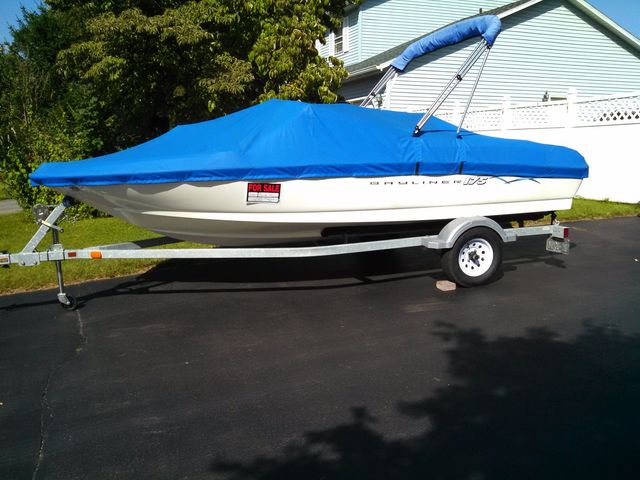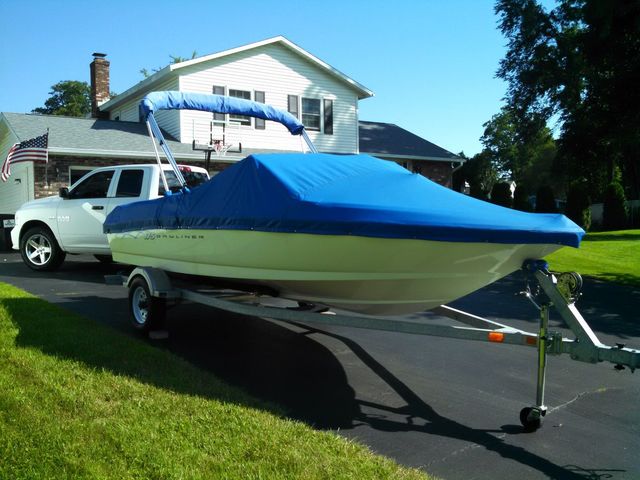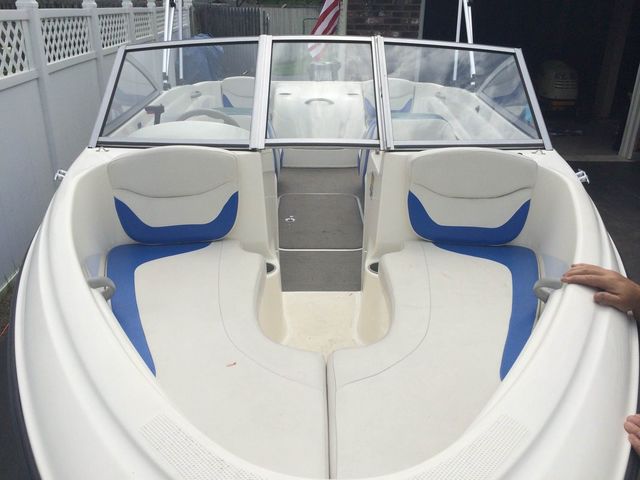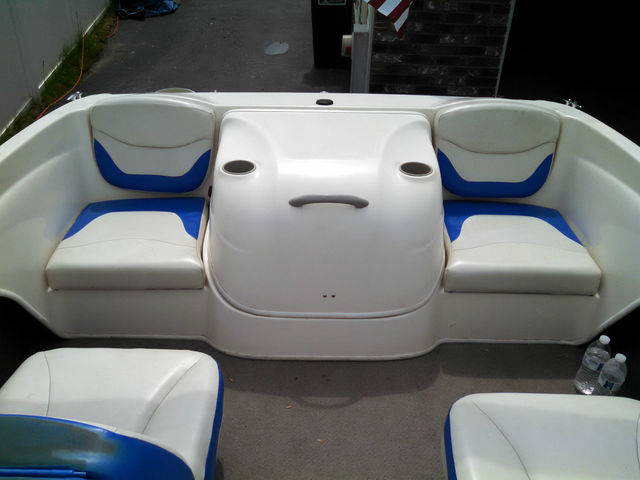Bayliner 175
- Price:
- Condition: Used
- Make: Bayliner
- Model: 175
- Type: Bowrider
- Year: 2006
- Hull Material: Fiberglass
- Trailer: Included
- Engine Type: Single Inboard/Outboard
- Engine Make: Mercury Engine
- Engine Model: 3.0L
- Primary Fuel Type: Gas
- Fuel Capacity: 11 - 20 Gallons
- Length:17.5 feet
- Location: Schenectady, New York, United States
Description
Hello up for auction is this beautiful 2006 Bayliner open bow seats 8 people, I am the second owner of this boat as it was purchased 3 years ago from CR's Marine here in Upstate NY and has only been in freshwater lakes, Lake George, Saratoga Lake and Sacandaga Lake, we do not have the time any longer to use the boat as my son is playing all kinds of sports now, it has been a great family boat for tubing fishing or sunbathing...whatever you choose to do this boat is ready to go. Includes 2007 Karavan Trailer, 6 life vests, Bimini Top, and all safety required equipment. Also comes with custom made canvas towable snap cover. 3.0 L 135 HPBayliner 175Well, I just got done testing the 175 bow rider on Lake Steven in Washington. This is a new model for Bayliner for 2003, targeting the buyer with limited funds for a boat. She has all the basic elements needed to make a fun little runabout at an affordable price.Starting with the hull, I slid under the 175 when she was on her trailer. At first glance I noticed the oversized reverse chines as well as the planing strakes and was told her deadrise was 19 degrees. So what does all this mean to us, the boater? Well, when I took her out for a ride with the camera crew of two she rode level, even with two of us on the same side; keep in mind she was not equipped with trim tabs. Normally smaller boats are more sensitive to uneven weight distribution as there is less hull surface to carry the load, but not this one. Another pleasant surprise was how she came up on plain even and really quick with three adult men onboard and only a 4-cylinder, 3-liter engine for power. By the way, this is the only power available right now for this model so forget getting creative with a big block from the factory. The engine-boat combo worked well delivering low 50s on the radar detector and believe me it felt a lot faster. In the turns the vessel leaned much less than I expected. This is also the result of the hard reverse chines holding her level. At speed I tried, for research purposes only of course, to bury the gunwale but to no avail. As a mater of fact, she tracked level and true through the turns now mater how hard I tried, and believe me I tried. Because of this sure handling, G force was more noticeable than on conventional hulls. Bayliner has installed a kill switch lanyard and on this boat, with the occasional mad man at the helm, it’s a good idea. The one thing that was uncomfortable and could be a problem, especially with an inexperienced boater, was the way the manual steering pulled hard when the trim was not adjusted just right. I let go of the wheel to see how the boat would react and she spun to port very fast, so use great care until you get use to it. At slower speeds there was a little spray but not enough to lose sleep over. The stringer system is Bayliner’s standard box system that they’ve used forever with good long-term success. The engine was a 135-hp, 3 liter, 4 cylinder raw water-cooled gas powered MerCruiser. No fancy whistles and bells here. But MerCruser has installed two little features that I really liked. First was a block and manifold cooling water drain system. It consisted of two hoses, each a yard in length, attached to the drain holes on the engine block and manifold. When the vessel was running, the hose ends clipped into a holding bracket mounted high on the front of the engine for easy access. When it comes time to drain the engine at the end of the day, simply unclip the hoses from the storage bracket and let them hang into the bilge to drain. Be aware that in this draining position water will pump into the bilge from the hoses when the engine is started possibly ruining your boating day. The 175 comes only with a manually activated bilge pump.The uppers were made from a singular molded fiberglass section sitting on the hull. This incorporated the decks, windshield cowlings, console, both stern quarter seats, and swim platform. The deck hardware was limited to four 6” cleats and a ski tow eye aft. The two aft cleats were located fine, but the bow cleats were mounted just forward of the windshield with none on the peak. Maybe it’s just me, but I prefer one all the way forward. Albeit thin, I did see stainless steel backing plates. A nice all black rubber rub rail covered the hull to deck joint. I found the interior was a very traditional bowrider layout. Very straight forward and a bit Spartan. The bow seating is simple having two bench seats facing each other with storage below. There were no bolsters against the inner hull but padded backrests were installed below the windshield on both sides. There was no storage behind the backrests but two well-located cup holders were molded into the seats. No door was installed in the passageway to the bow section, which created a wind tunnel effect when at speed even with the windshield closed. The windshield was a very plain straightforward aluminum framed safety glass affair with the center pain opening out to port. The plastic retaining clip for the center section wasn’t very substantial and appears destined to fail after prolonged use. Admittedly it worked well during the testing. Aft of the windshield on the starboard side was the console, a pleasant surprise. The gauges were laid out in an arch quite pleasing to the eye. But the gauges themselves were really nice with gold accents on a silver field; very classy looking. The helm wheel had a nice stitched vinyl wheel but wasn’t adjustable. On the passenger side dash was a large open molded pan with a drain for ice and drinks without a lid. Mounted in the forward wall for the pan was the detachable face stereo radio with a protective door. Next was the traditional back-to-back break down seats. By lifting the seat's forward edge, the bottom slides out and permits the back to flatten out to a sunning bed. They also line up with the stern seats to add to their length. The passengers seat was situated in such a way that a 5’9” persons knees were firmly into the dash. This was not the case with the helm seat as it was mounted further aft. I found that standing behind the wheel however was all but impossible not being able to raise the wheel out of the way. Out board of the seats was a padded kick board to create a simple storage area against the hull; plain but effective. There was no easy access to the space below the seats for storage. The deck was carpeted in the cockpit area and with the hull lined with a fuzzy material the combo-looked good. In each aft corner of the cockpit was a seat that was separated by the engine compartment cover that doubled as a table with cup holders. Last but not least was a surprisingly roomy swim platform running full beam bridging the out drive unit and fairly deep. The surface had a non-skid pattern, as did all the weather decks though out the vessel. A two-rung telescoping stainless steel boarding ladder with rubber-covered steps was mounted on the starboard side. The ladder was hinged so as to store in a recessed area in the deck surface with a plastic retaining clip. When needed it easily lifts up and over into the water. Watch your hands when brining it back up as the lower section will drop into the upper and can pinch skin. Ouch.The 175 has nice lines that lend a European flair to the overall look of the boat. Add in the tape accent stripes with graphics and she looks pretty good. She also has the handling characteristics of boats costing much more. The ride was quite secure, level and she jumped up on plane eagerly. So if it’s thick padded seats and creature comforts your looking for this is not the boat. But for fun and easy handling at an affordable price, check it out Bayliner 175Well, I just got done testing the 175 bow rider on Lake Steven in Washington. This is a new model for Bayliner for 2003, targeting the buyer with limited funds for a boat. She has all the basic elements needed to make a fun little runabout at an affordable price.Starting with the hull, I slid under the 175 when she was on her trailer. At first glance I noticed the oversized reverse chines as well as the planing strakes and was told her deadrise was 19 degrees. So what does all this mean to us, the boater? Well, when I took her out for a ride with the camera crew of two she rode level, even with two of us on the same side; keep in mind she was not equipped with trim tabs. Normally smaller boats are more sensitive to uneven weight distribution as there is less hull surface to carry the load, but not this one. Another pleasant surprise was how she came up on plain even and really quick with three adult men onboard and only a 4-cylinder, 3-liter engine for power. By the way, this is the only power available right now for this model so forget getting creative with a big block from the factory. The engine-boat combo worked well delivering low 50s on the radar detector and believe me it felt a lot faster. In the turns the vessel leaned much less than I expected. This is also the result of the hard reverse chines holding her level. At speed I tried, for research purposes only of course, to bury the gunwale but to no avail. As a mater of fact, she tracked level and true through the turns now mater how hard I tried, and believe me I tried. Because of this sure handling, G force was more noticeable than on conventional hulls. Bayliner has installed a kill switch lanyard and on this boat, with the occasional mad man at the helm, it’s a good idea. The one thing that was uncomfortable and could be a problem, especially with an inexperienced boater, was the way the manual steering pulled hard when the trim was not adjusted just right. I let go of the wheel to see how the boat would react and she spun to port very fast, so use great care until you get use to it. At slower speeds there was a little spray but not enough to lose sleep over. The stringer system is Bayliner’s standard box system that they’ve used forever with good long-term success. The engine was a 135-hp, 3 liter, 4 cylinder raw water-cooled gas powered MerCruiser. No fancy whistles and bells here. But MerCruser has installed two little features that I really liked. First was a block and manifold cooling water drain system. It consisted of two hoses, each a yard in length, attached to the drain holes on the engine block and manifold. When the vessel was running, the hose ends clipped into a holding bracket mounted high on the front of the engine for easy access. When it comes time to drain the engine at the end of the day, simply unclip the hoses from the storage bracket and let them hang into the bilge to drain. Be aware that in this draining position water will pump into the bilge from the hoses when the engine is started possibly ruining your boating day. The 175 comes only with a manually activated bilge pump.The uppers were made from a singular molded fiberglass section sitting on the hull. This incorporated the decks, windshield cowlings, console, both stern quarter seats, and swim platform. The deck hardware was limited to four 6” cleats and a ski tow eye aft. The two aft cleats were located fine, but the bow cleats were mounted just forward of the windshield with none on the peak. Maybe it’s just me, but I prefer one all the way forward. Albeit thin, I did see stainless steel backing plates. A nice all black rubber rub rail covered the hull to deck joint. I found the interior was a very traditional bowrider layout. Very straight forward and a bit Spartan. The bow seating is simple having two bench seats facing each other with storage below. There were no bolsters against the inner hull but padded backrests were installed below the windshield on both sides. There was no storage behind the backrests but two well-located cup holders were molded into the seats. No door was installed in the passageway to the bow section, which created a wind tunnel effect when at speed even with the windshield closed. The windshield was a very plain straightforward aluminum framed safety glass affair with the center pain opening out to port. The plastic retaining clip for the center section wasn’t very substantial and appears destined to fail after prolonged use. Admittedly it worked well during the testing. Aft of the windshield on the starboard side was the console, a pleasant surprise. The gauges were laid out in an arch quite pleasing to the eye. But the gauges themselves were really nice with gold accents on a silver field; very classy looking. The helm wheel had a nice stitched vinyl wheel but wasn’t adjustable. On the passenger side dash was a large open molded pan with a drain for ice and drinks without a lid. Mounted in the forward wall for the pan was the detachable face stereo radio with a protective door. Next was the traditional back-to-back break down seats. By lifting the seat's forward edge, the bottom slides out and permits the back to flatten out to a sunning bed. They also line up with the stern seats to add to their length. The passengers seat was situated in such a way that a 5’9” persons knees were firmly into the dash. This was not the case with the helm seat as it was mounted further aft. I found that standing behind the wheel however was all but impossible not being able to raise the wheel out of the way. Out board of the seats was a padded kick board to create a simple storage area against the hull; plain but effective. There was no easy access to the space below the seats for storage. The deck was carpeted in the cockpit area and with the hull lined with a fuzzy material the combo-looked good. In each aft corner of the cockpit was a seat that was separated by the engine compartment cover that doubled as a table with cup holders. Last but not least was a surprisingly roomy swim platform running full beam bridging the out drive unit and fairly deep. The surface had a non-skid pattern, as did all the weather decks though out the vessel. A two-rung telescoping stainless steel boarding ladder with rubber-covered steps was mounted on the starboard side. The ladder was hinged so as to store in a recessed area in the deck surface with a plastic retaining clip. When needed it easily lifts up and over into the water. Watch your hands when brining it back up as the lower section will drop into the upper and can pinch skin. Ouch.The 175 has nice lines that lend a European flair to the overall look of the boat. Add in the tape accent stripes with graphics and she looks pretty good. She also has the handling characteristics of boats costing much more. The ride was quite secure, level and she jumped up on plane eagerly. So if it’s thick padded seats and creature comforts your looking for this is not the boat. But for fun and easy handling at an affordable price, check it out
More Bayliner classic cars for sale
 Bayliner 1987 Bayliner Ciera 2150, Sunbridge Cuddy Cabin
Bayliner 1987 Bayliner Ciera 2150, Sunbridge Cuddy Cabin
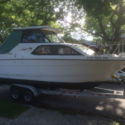 Bayliner Bayliner 2452 Ciera Classic Cruiser
Bayliner Bayliner 2452 Ciera Classic Cruiser
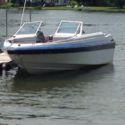 Bayliner Bayliner Capri 2150
Bayliner Bayliner Capri 2150
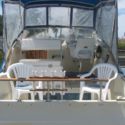 Bayliner Bayliner Sunbridge 2850
Bayliner Bayliner Sunbridge 2850
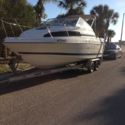 Bayliner Bayliner 2252 Cuddy
Bayliner Bayliner 2252 Cuddy
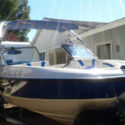 Bayliner 19 Ft 2007 Bayliner 195 BR Flight
Bayliner 19 Ft 2007 Bayliner 195 BR Flight
 Bayliner Custom / Bayliner Reflexx
Bayliner Custom / Bayliner Reflexx
 Bayliner Custom / Bayliner Reflexx
Bayliner Custom / Bayliner Reflexx
 Bayliner 1987 Bayliner Ciera 2150, Sunbridge Cuddy Cabin
Bayliner 1987 Bayliner Ciera 2150, Sunbridge Cuddy Cabin
Year: 1987
Make: Bayliner
Model: 1987
Length: 22.0 feet
Location: United States
Make: Bayliner
Model: 1987
Length: 22.0 feet
Location: United States
 Bayliner Bayliner 2452 Ciera Classic Cruiser
Bayliner Bayliner 2452 Ciera Classic Cruiser
Year: 2003
Make: Bayliner
Model: 2003
Length: 24.0 feet
Location: Fresh Meadows, New York, United States
Make: Bayliner
Model: 2003
Length: 24.0 feet
Location: Fresh Meadows, New York, United States
 Bayliner Bayliner Capri 2150
Bayliner Bayliner Capri 2150
Year: 1986
Make: Bayliner
Model: 1986
Length: 21.5 feet
Location: Hillsdale, Michigan, United States
Make: Bayliner
Model: 1986
Length: 21.5 feet
Location: Hillsdale, Michigan, United States
 Bayliner Bayliner Sunbridge 2850
Bayliner Bayliner Sunbridge 2850
Year: 1980
Make: Bayliner
Model: 1980
Length: 28.0 feet
Location: Quartzsite, Arizona, United States
Make: Bayliner
Model: 1980
Length: 28.0 feet
Location: Quartzsite, Arizona, United States
 Bayliner Bayliner 2252 Cuddy
Bayliner Bayliner 2252 Cuddy
Year: 1998
Make: Bayliner
Model: 1998
Length: 23.0 feet
Location: Fort Pierce, Florida, United States
Make: Bayliner
Model: 1998
Length: 23.0 feet
Location: Fort Pierce, Florida, United States
 Bayliner 19 Ft 2007 Bayliner 195 BR Flight
Bayliner 19 Ft 2007 Bayliner 195 BR Flight
Year: 2007
Make: Bayliner
Model: 2007
Length: 19.0 feet
Location: Reno, Nevada, United States
Make: Bayliner
Model: 2007
Length: 19.0 feet
Location: Reno, Nevada, United States
 Bayliner Custom / Bayliner Reflexx
Bayliner Custom / Bayliner Reflexx
Year: 2009
Make: Bayliner
Model: 2009
Length: 14.0 feet
Location: North East, Maryland, United States
Make: Bayliner
Model: 2009
Length: 14.0 feet
Location: North East, Maryland, United States
 Bayliner Custom / Bayliner Reflexx
Bayliner Custom / Bayliner Reflexx
Year: 2009
Make: Bayliner
Model: 2009
Length: 14.0 feet
Location: North East, Maryland, United States
Make: Bayliner
Model: 2009
Length: 14.0 feet
Location: North East, Maryland, United States
